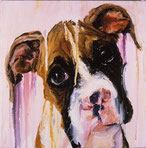PAINT AND TECHNIQUE IN THE EARLY WORK
Since it's hard to see an details of my paint surface itself--even when the images on the site are expanded--I think a word or two here might be helpful. This discussion will focus on the technique and paint quality of the early work. Later discussions will focus on later paintings and on the drawings.
Starting in the early 1990s I began using paint mixed with loads of damar varnish and stand oil mixed directly in with the tube paint. I had developed this formulation in large measure because I wanted the paint to frustrate my tendency to be too fussy.
For the same reason, I took to using a palette knife instead of brushes. I had never used a knife before the early 90s, and it felt--intially anyway--like being forced to right with the wrong hand. Even when I grew adept, though, using a knife still forced me to work on broader areas than any brush would allow. Fussy details would have to remain at a minimum, which is evident if you look at paintings from 1993-1994. There were other advantages as well: a knife moved the viscous paint mixture around more effectively than did any brush I had because the brushes all tended to get gummed up with the sticky medium. Knives, conversely could scrape and sculpt whole sections, much like lifting cake batter from the side of a bowl with a spatula.
Another attribute of this early paint medium became apparent: I had to work quickly. There were really two reasons for this. One was that my paintings were extraordinarily shiny, and when I tried to paint over the first layers I found that the paint simply couldn't get any purchase. It simply slid right on to the floor. Not only would these paintings need to be finished in one layer, with no over-painting, they would need to be finished in one day. That is because varnish dries much faster than tube paint itself or tube paint mixed with more traditional media. Even if I only confined my painting to one area a day, I found that the next days area wouldn't mix and meld with what I had done previously. Each day's work would look like individual pieces of a jigsaw puzzle. Only rarely, and only with very careful planning, could I stretch a painting out to more than one day. In general, all of the work from the early 1990s was done in one day.
Additionally, because the paint was so runny, nothing I completed in one day would ever look exactly the same the next day. Not only would rivuletes of paint stream down from the top of the painting drip into areas lower down, but broad sections a few inches across would slip down the canvas like a raft afloat in a current. I'd paint a nose exactly how I wanted it to look, and exactly where I wanted it to be, only to see it warp and drip as gravity took hold.
What you see in the early paintings--and to some extent in later work as well--is really the combination of what I did with a knife (and/or brush in work after 1994), and what the physical qualities of the paint did on its own while I was painting and after I left the studio for the day. In other words, the early paintings are really the combination of artistic intention and gravity. And, here again, this worked perfectly as a counterpoint to my tendency to overwork a painting.
I continued using this paint through the mid 90s, though I did reformulate the early medium because I began to notice that work from earlier than 1993 (not exhibited on this site now) began to yellow and crack with age. I didn't mind the cracking, in fact, I sort of liked the way the cracks looked, but I really didn't like the way the colors had changed so dramatically: blues began to look green, and reds shifted to orange. Because the color shifted affected the cool colors more than the warm ones--especially the yellows--my carefully calibrated color relationships were thrown off. As a result, I re-formulated the medium a bit, so that the paintings wouldn't change color as they aged.
Because of this change my paintings became a bit less radically drippy, starting in the mid-90s. Not that this is to say that I didn't continue to make paintings with paint that were unconventially runny, but less so than in the early years when the process was less in my control.
If you go through the paintings chronoligically, you'll see some years where the paintings are fairly tight, and other years where the paint is fairly loose and athletic. I like shifting back and forth between different strategies, and I enjoy the freedom I've allowed myself to use a broader array of strategies and tactics than I did early on in my painting.
And, as a bonus, I've found these paintings retain their original vibrant colors.
 andrew ehrenworth
andrew ehrenworth
